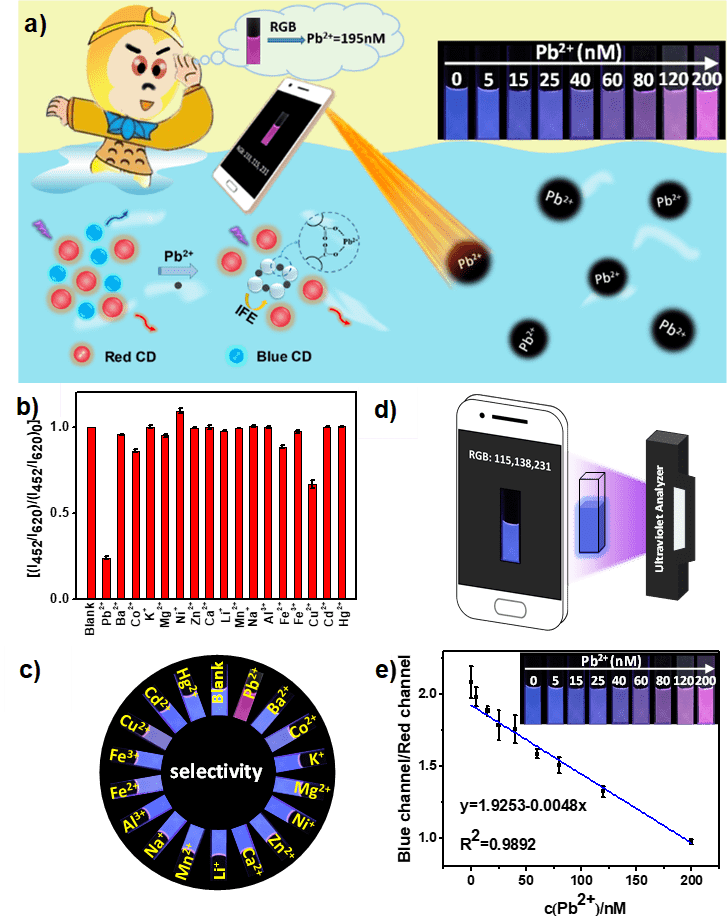Jul 1 2019
A Chinese study team has come up with an effective colorimetric fluorescent detection of lead ions in water and realized real-time, visual, and semi-quantitative detection by printing the paper strip with fluorescence probe solution and a smartphone application (Color recognizer, Xiyi Technology).
 Figure: a) Schematic illustration of visual detection of lead ions in water; b) The selectivity of colorimetric fluorescent probes to detect lead ions; c) The fluorescent images corresponding to the selectivity of detect lead ions (photographed under 365 nm UV light); d) Schematic drawing for the detection of Pb2+ using a smartphone; e) The plot of fluorescence probe solution color change (blue channel/red channel) versus concentration of Pb 2+ (insets show that photos were taken with a smartphone under a 365 nm UV lamp) (Image credit: WANG Haiqian)
Figure: a) Schematic illustration of visual detection of lead ions in water; b) The selectivity of colorimetric fluorescent probes to detect lead ions; c) The fluorescent images corresponding to the selectivity of detect lead ions (photographed under 365 nm UV light); d) Schematic drawing for the detection of Pb2+ using a smartphone; e) The plot of fluorescence probe solution color change (blue channel/red channel) versus concentration of Pb 2+ (insets show that photos were taken with a smartphone under a 365 nm UV lamp) (Image credit: WANG Haiqian)
This research was carried out by Jiang Changlong and his contemporaries with Institute of Intelligent Machines (IIM), Hefei Institutes of Physical Science. It was reported in Analytical Chemistry.
Among the metal ions, lead is said to be one of the most poisonous elements as it damages human health and contaminates the environment. Traditional approaches to detecting lead ions can fulfill the sensitive and selective examination of the amount of Pb2+ in water sample. But, the application of these technologies is restricted by the high cost of instruments, the long testing period, and the need for skilled operation.
So as to realize semi-quantitative visual detection of lead ions, the researchers prepared colorimetric fluorescent probe by mixing blue carbon dots (BCDs,) and red carbon dots (RCDs) with a fixed fluorescence intensity ratio.
As the amount of Pb2+ grows, the decline of the blue fluorescence intensity made the luminescence color noticeable from blue to red, which could be easily detected using a smartphone under a UV lamp.
When the smartphone was combined with fluorescent paper strips, the immediate semi-quantitative detection of metal ions could be performed.
The research exposed that the detection limits of the fluorescent probe solution were 2.89 nM and 35.26 nM, respectively by using luminescence spectrometer and the smartphone application, which were a lot lower than acceptable limit of Pb2+ (10 mg·L-1) for drinking water (WHO).
The smartphone detected the RGB values of fluorescent paper strips on-site and semi-quantitative detection of lead ions in water could be achieved in 5 minutes.
This research received financial support from the National Natural Science Foundation of China, the National Basic Research Program of China and the Key Research and Development Program of Anhui Province.